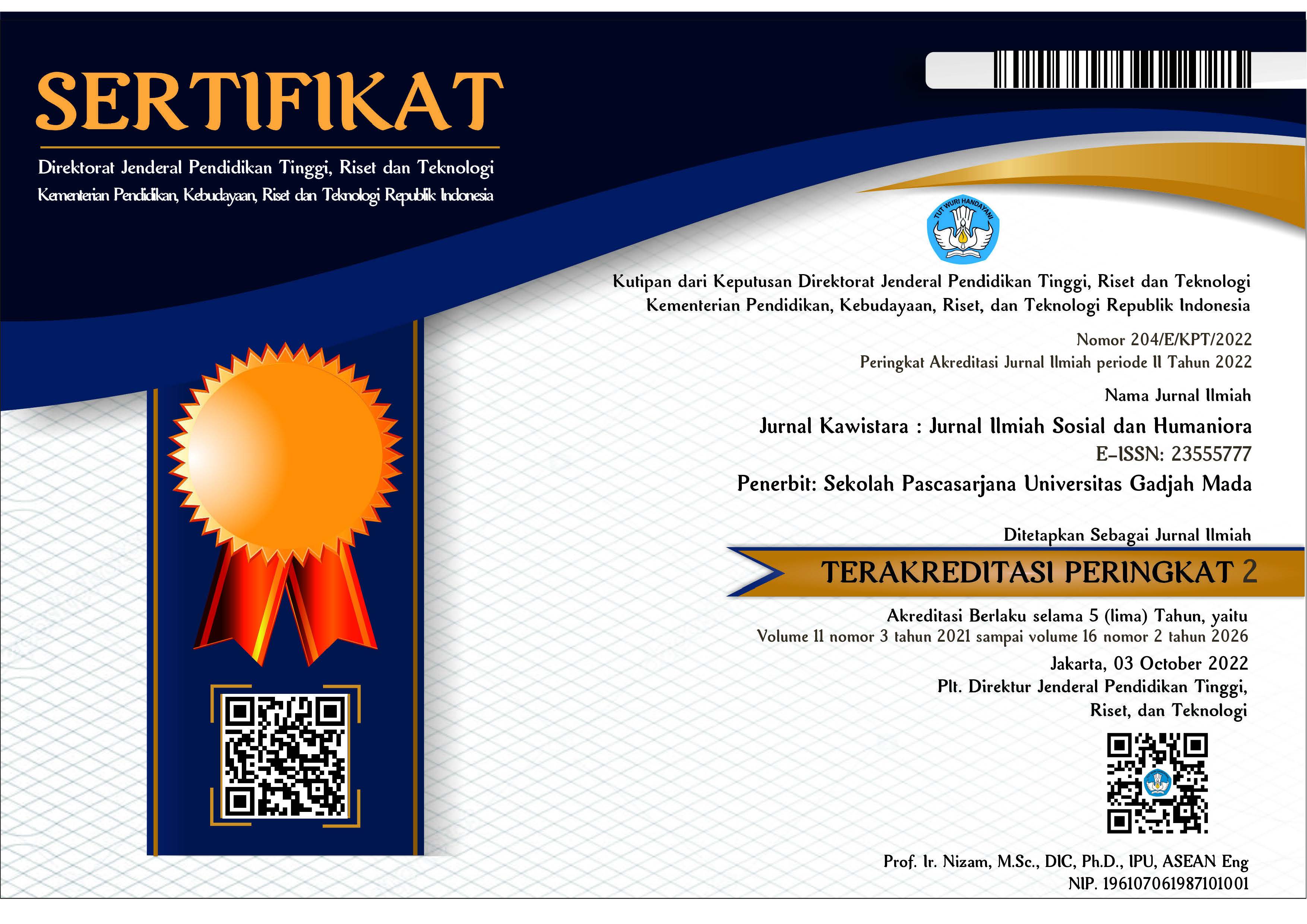KOMODIFIKASI BARONGSAI MENJAGA TRADISI MENEGOSIASI PASAR
Moch. Choirul Arif(1*), GR. Lono Lastoro Simatupang(2), Budiawan Budiawan(3)
(1) Fakultas Dakwah dan Komunikasi Universitas Islam Negeri Sunan Ampel Surabaya
(2) Jurusan Antropologi Fakultas Ilmu Budaya Universitas Gadjah Mada
(3) Program Studi Kajian Budaya dan Media Sekolah Pascasarjana Universitas Gadjah Mada
(*) Corresponding Author
Abstract
After the fall of the Soeharto regime was like the fresh air for the ethnic Chinese in Indonesia in
articulating cultural identities, especially after the issuance of Presidential decree Number 6 of 2000
which revoked Presidential Instruction Number 14 of 1967 on religion, beliefs, and customs of China.
With that Presidential decree, Chinese people were free to celebrate the religious ceremony and customs,
as well as featuring Barongsai (Lion Dance) in front of public. Consequently, Barongsai became popular
and transformed into a cultural icon as well as “obligatory menu” for city event. Barongsai allegedly
underwent commodification along with its popularity. However, that signal was responded by
Barongsai activists as the consequence of efforts to survive and conquer the market. Through the mindset
of yin and yang, commodification discourse is abrogated and appropriated by Barongsai activists, so
commodification is not just an effort to maintain and preserve the ancestral cultural heritage, identity,
and cultural pride due to the accomplishments achieved
Keywords
References
] Abdullah, Irwan. 2010. Konstruksi dan Reproduksi Kebudayaan, Yogyakarta: Pustaka Pelajar.
] Baso, Ahmad. 2006. NU Studies, Pergolakan Pemikiran Antara Fundamentalisme Islam dan Fundamentalisme Neo-Liberal, Jakarta: Penerbit Erlangga.
] Featherstone, Mike. 2008. Postmodernisme dan Budaya Konsumen, Yogyakarta:Pustaka Pelajar.
] Hew, Wai Weng. 2013. “Expressing Chineseness,marketing Islam; the hybrid performance of Chinese Muslim preachers”. Dalam Chang Yao Hoon dan Siew Min Sai. Chinese Indonesians Reassessed; History, religion and belonging, London dan New York:Routledge.
] Hoon, Chang You. 2012. Identitas Tionghoa Pasca Suharto Budaya, Politik, dan Media, Jakarta: LP3ES.
] Lee, Martin J. 2006. Budaya Konsumen Terlahir Kambali, Arah baru Modernitas dalam Kajian Modal Konsumsi dan Kebudayaan,Yogyakarta: Kreasi Wacana.
] Malagina, Agni. 2010 “Tarian Barongsai nan Eksotis; Dari Global ke Lokal,Kembali ke Global” dalam I Wibowo dan Thung ju lan, Setelah Air Mata Kering: Masyarakat Tionghoa Pasca Peristiwa Mei 1998, Jakarta: PT Kompas Media Nusantara.
] Meethan, K. 2001. Tourism in global society:place, culture, consumption, New York: Palgrave.
] Mosco, Vincent. 1996. The Political Economy of Communications¸London: Sage Publication.
] Mosco, Vincent. 2009. Cetakan Kedua. The Political Economy of Communications¸London: Sage Publication.
] Samuel, R. 1994. Theatres of Memory, London:Verso.
] Simatupang, GR Lono Lastoro. 2013. Pagelaran: Sebuah Mozaik Penelitian Seni Budaya, Yogyakarta: Jalasutra.
] Sunder, M. 2005. Property in personhood In M. Ertmann & J. Williams (Eds.),Rethinking commodification, New York: New York University Press.
] Suyanto, Bagong. 2013. Sosiologi Ekonomi;Kapitalisme dan Konsumsi di Era Masyarakat Post-Modernisme, Jakarta:Kencana Prenada Media Grup.
] Suryadinata, Leo. 2010. Tokoh Tionghoa dan Indentitas Indonesia: Dari Tjou Bou San Sampai Yap Thiam Hien, Komunitas Bambu
Article Metrics
Refbacks
- There are currently no refbacks.
Copyright (c) 2016 Moch. Choirul Arif, GR. Lono Lastoro Simatupang, Budiawan Budiawan

This work is licensed under a Creative Commons Attribution-ShareAlike 4.0 International License.
Jurnal Kawistara is published by the Graduate School, Universitas Gadjah Mada.











